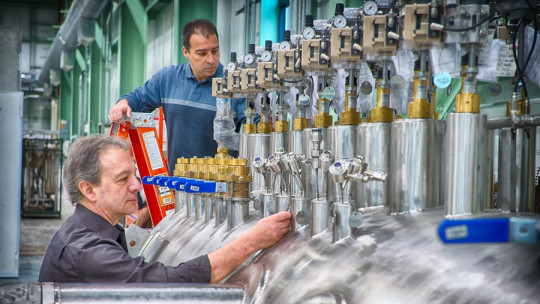There are many different types of costs in a company Based on the criteria used, the economic activity being analyzed and the type of level being taken into account, we can talk about many different types of costs.
Whatever they may be, in every organization you must take into account and know the types of costs that may occur within your institution, in order to anticipate them, have them well recorded and, to the extent possible, reduce costs and increase benefits. .
Types of costs in a company depending on the function in which they are incurred
The types of costs in a company are very varied and Its categorization depends on several aspects to be taken into account, in addition to the criteria used Below we will see these criteria in addition to each of the categories within them.
According to the function in which they are incurred, we can talk about production, distribution or sales, administration and financial costs.
Production costs
Production costs are those derived from the process in which a raw material is transformed into a manufactured product Within them we can find the following three subtypes:
1. Raw material costs
Raw material costs are those directly related to the cost of materials integrated into the product , that is, what the product physically costs. For example, it would be the cost of the wood that makes up a table, the malt for beer, or the clay for a piece of pottery.
2. Labor costs
Labor costs are those derived from direct intervention in the transformation of matter into a manufactured product
For example, labor costs would be the salary of the carpenter who made a table, the farmer who collected the malt, the miner who obtained the clay.
3. Indirect manufacturing costs
Indirect manufacturing costs are expenses associated with production that occur during the transformation of raw materials into a product but are not derived directly from labor Among them we could find the salary of the artisans’ supervisors, maintenance, energy consumption, depreciation…
There are many costs that can occur in a factory or in the production chain that are indirect for the production of a product or the offering of a service that do not depend on direct raw materials or labor.
Distribution or sales costs
Distribution or sales costs are those that incurred in the area that is responsible for taking the finished products from the place of production to the consumer They are also those that are related to the promotion and sale of the product or service, such as advertising, commissions, supply in establishments where they are sold…
Administration costs
Administration costs are those that, as their name indicates, originate from the administrative activity of the company. They are directly related to the direction and management of the general operations of the company among which we can find salaries, telephone expenses, general offices, communication services within the organization…
Financial costs
The financial costs are those that They originate from obtaining external resources that the company needs for its development These include the cost of interest that the company must pay on loans, as well as the cost of granting credit to customers.
Types of costs according to their identification with an activity, department or product
Within this classification we find direct costs and indirect costs.
Direct costs
The direct costs are those that can be identified or quantified with finished products or specific areas They are those that management is able to associate with the given services or items. Among them we would also find the salary corresponding to the sales director’s secretary, the cost of raw materials, the cost of labor…
Indirect costs
Unlike direct costs, indirect costs are those that cannot be fully identified or quantified with finished products or specific areas An example of indirect cost is the depreciation of machinery or the salary of the production director with respect to the product.
Some costs are dual, in the sense that they are direct and indirect at the same time. A case of this is the salary of the production manager, which is direct for the costs of the production area, but indirect for the product. Defining whether a cost is direct or indirect depends quite a bit on the activity being analyzed.
According to the time in which they were calculated
Within this criterion we find historical costs and predetermined costs.
Historical costs
Historical costs, also known as real costs, are those that occur after the product has been manufactured This type of costs indicate what it cost to produce a certain good or service. Historical costs are those used when preparing external financial statements.
Default costs
The predetermined costs are those that They are calculated before or during the production of a certain item or service in an estimated manner or by applying the standard cost
1. Estimated costs
We say that a cost is estimated when it is calculated on certain empirical bases but remains approximate. That is, it is a forecast or forecast of the value and amount of costs that will occur during the production of the product or the offer of a service
2. Standard costs
Standard costs are those that are carried out on a generally scientific basis on each of the elements of the cost of a specific item or service. Is the calculation believed to be exact of what a product or service should cost to produce or offer as long as there are no surprises and based on how the production has been until that moment.
According to the time in which they are charged to income
Within this criterion we find the costs of the products and period
Product costs
Product costs, as its name indicates, refers to those that have occurred as a consequence of the production and sale of the product, regardless of the type of sale
Period costs
Period costs are those that occur during a certain period of time. They can be daily, weekly, biweekly and, at most, monthly For example, it may be that the company is occupying rental offices whose cost is incurred in a specific period (normally a month) and that is independent of how many products or services the company offers.
Depending on the control you have over its occurrence
Here we find controllable costs and non-controllable costs.
Controllable costs
Controllable costs are those that one or more people have the authority to carry out For example, the salaries of sales directors are costs controllable by their immediately superior level, the general sales director. Another example is the secretary’s salary, which depends directly on what your boss decides.
Actually, most of a company’s costs, especially salaries, are controllable at one level or another of the organization. At lower levels this aspect is much less controllable, while at higher levels it is almost maximum. The director of the entire organization can influence the salary of all his workers, while the lowest echelon does not even influence his own.
You should not think that controllable costs are equal to direct costs For example, the salary of a production director is direct with respect to his area, but is not controllable by him. These costs are those used to design accounting by areas of responsibility or any other administrative control system.
Uncontrollable costs
Sometimes there is no authority over the costs that are managed An example of this is the depreciation of equipment for the supervisor, since such an expense is usually a decision made by senior management.
According to your behavior
In this criterion we find fixed costs, variable costs, and mixed costs.
Fixed costs
Fixed costs are those that They do not undergo any alteration with the passage of time, being constant even when there are large fluctuations in terms of production or other aspects. Among the fixed costs we have aspects such as the payment of factory rent, the depreciation of fixed-line assets or by coefficients, the cost accountant’s salary, insurance, salaries, the salary of security guards…
These are usually those expenses necessary to sustain the structure of the company and that are carried out periodically. Within the fixed costs we can find:
1. Discretionary fixed costs
Discretionary fixed costs are those susceptible to being modified at some point, such as the salaries of workers the rental of the building, the production process itself…
2. committed fixed costs
Committed fixed costs, also called sunk costs, are those that They are not modified by anything An example of this would be the depreciation of machinery.
Variable costs
Variable costs are those whose magnitude changes in direct proportion to the volume of operations carried out within the company This activity can be referred to production or sales. For example, spending on raw materials changes both due to variations in their value and in the quantity required as production increases.
Mixed costs
As its name suggests, mixed costs have the characteristics of fixed and variable costs throughout several relevant ranges of operations.
1. Semi-variable cost
The fixed part of a semivariable cost usually represents a minimum charge when making a certain product or offering a service. Its variable part is the cost charged for actually using the service
For example, most charges for telephone services consist of two elements: the fixed charge, which allows the user to receive or make calls, and the variable charge for each telephone call made.
2. Stepped cost
In scaled cost its fixed part changes abruptly at different activity levels since these costs are acquired in indivisible parts.
This idea is somewhat complex to understand so let’s see an example. Let’s imagine that one supervisor is required for every 20 workers. If there were 30 workers we would need two supervisors and, if we hire other workers until we reach 40 we would still only need two supervisors. But if we reach 41 workers we will require three supervisors, since we need an extra one for every 20 workers.
According to their importance for decision making
Here we find relevant costs and irrelevant costs.
Relevant costs
The relevant costs are those future expenses that They are expected to differ between alternative courses of action and may be discarded if any step or economic activity is changed, reduced or eliminated
Irrelevant costs
They are those that remain unchanged, regardless of the chosen course of action.
Depending on the type of sacrifice incurred
In this criterion we find disbursable and opportunity costs.
Out-of-pocket costs
Disbursable costs are those that involve the outflow of cash These expenses will later become historical costs and may or may not be relevant when making administrative decisions.
Opportunity cost
When a new decision is made to apply a certain alternative, the benefits that other options would have brought are abandoned. The hypothetical benefits lost by discarding other, perhaps better, alternatives, These are what are called opportunity costs for the chosen action
According to the change caused by an increase or decrease in activity
In this criterion we can find differential costs and sunk costs.
Differential costs
Differential costs refer to increases or decreases in total cost, or the change in any cost element produced by a variation in the company’s operation. These costs are important during decision making, since they are the ones show the changes, beneficial or negative, that have occurred in the company following a special request
1. Decremental costs
When differential costs occur due to reductions in the volume of the operation, we speak of incremental costs.
2. Incremental costs
Incremental costs are those that are caused by the increase in the activities or operations of the company
Sunk costs
Sunk costs are those that Regardless of the action chosen, they will not be altered, that is, they will remain unchanged
According to its relationship to the reduction of activities
In this last criterion we find avoidable costs and unavoidable costs.
Avoidable costs
Avoidable costs are those that They are fully identifiable with a product or department so, in this way, if the product or department is eliminated, that cost is eliminated
Unavoidable costs
Unavoidable costs are those that are not eliminated, even if the department or product associated with them or suspiciously associated with them is eliminated from the company.









